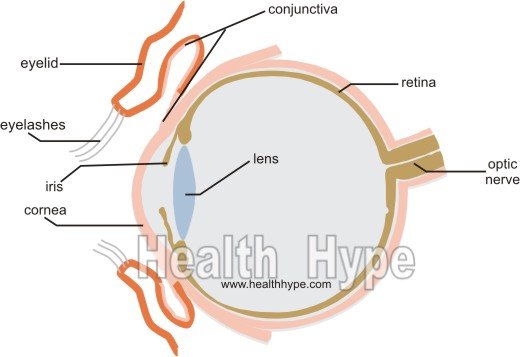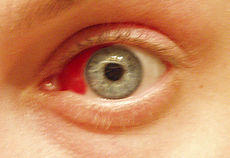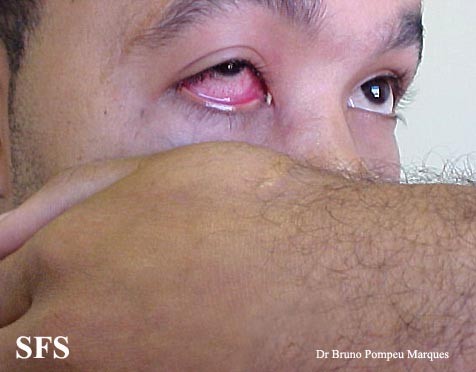Burning Eyes and Heat Sensation in One or Both Eyes
The eyes are made up of very delicate tissue, some of which are exposed to the environment. Although the thin outer lining known as the conjunctiva and the eyelids protect the eye tissue, the eyes are more prone to various forms of injury more so than any other part of the body. Naturally when one is faced with an injury to the face, it is instinct to first cover the eyes.
Eye Discomfort
Being such sensitive parts of the body, it is normal for discomfort to arise in the eyes even with a little strain or slight injury. One of the common sensations that a person experiences in the eye is a burning feeling, which can sometimes be severe enough to be painful. At other times there may be the sensation of heat in the eyes without actually feeling like a burn.
Both these sensations, burning and heat, can be due to a number of causes some of which are minor while others can be very serious and even permanently damage the eye. Other types of discomfort may include an aching feeling, soreness or grittiness in the eyes.
It is often difficult to distinguish between burning and a sensation of heat emanating from the surface of the eyeball exposed to the environment, within the eye and sometimes even behind the eye. Most irritation is associated with the conjunctiva, cornea, lens and its suspensory ligaments and ciliary muscles.

Parts of the Human Eye
Burning Sensation
A burning sensation is usually an indication of some irritation or inflammation. It is often the first sensation a person will experience before pain sets in, only if the irritation or inflammation is severe enough. A burning sensation in the eye should therefore be seen as a warning that the eye is under strain and needs to be investigated.
Heat Sensation
Although burning is the feeling of excessive heat, sometimes the eyes feel like there is heat radiating out of it. Another related sensation in the eyes is that it is in close proximity to heat although there is no heat source near it. This heat sensation often precedes burning in the eyes. It is also an indication that the eye is irritated or inflamed but to a lesser degree than when there is burning or pain.
Other Eye Symptoms
Burning eyes and a heat sensation is a symptom and not a disease. Sometimes these uncomfortable feelings may occur on its own but there may also be other eye symptoms which can help to indicate a cause. The common eye symptoms that may occur with burning eyes includes :
- Eye pain
- Redness of the eyes
- Watery eyes or dry eyes
- Itchy eyes
- Swelling of the eye and around it
- Light sensitivity (photosensitivity)
- Blurred vision or double vision
- Loss of vision, either partial or complete (blindness)
- Abnormal images like flashing lights or floaters
- Eye discharge, sometimes even with blood
All of these eye symptoms may occur for specific reasons although on its own the exact cause is not clearly apparent. Sometimes there are other symptoms that may also occur at the same time yet it does not affect the eye. These additional symptoms may include :
- Headache
- Swelling around the eye
- Swollen and painful eyelids
- Cheek pain
- Runny nose
- Nasal congestion
- Sneezing
- Post nasal drip
- Nausea
- Fever
- Loss of balance
- Weakness or even paralysis of a part of the body
Causes of Burning Eyes
There is no single or specific cause of burning eyes. As with any part of the body, when it is strained or irritated, the first warning signal may be symptoms like burning or a heat sensation. This is due to inflammation – a protective mechanism in the body when any tissue is injured.

One of the processes in inflammation is to increase the blood flow to an area. This can often be experienced as heat. Another feature of inflammation is discomfort, burning or pain because of the chemicals that accumulate in the area. Inflammation, however, is non-specific and can occur due to any number of causes. Sometimes it even happens for no apparent reason.
Eye Strain
The most common cause of burning in the eyes and a sensation of heat is eye strain. Every person experiences eye strain at some time or the other in life. It can occur as a once off episode or be a daily occurrence. Some of the causes of eye strain includes :
- Watching television, reading a book or looking at a computer screen for long hours.
- Reading in dim light.
- Eyesight problems like nearsightedness (myopia), farsightedness (hyperopia) or astigmatism, especially when corrective eye glasses or contact lenses are not used.
- Exposure to bright lights and harsh sunlight without protective wear like sunglasses.
Eye strain has become an even more common cause of burning eyes in this day and age where more people, both adults and children, are occupied in staring at screens for long hours. This may include the television, computer or even mobile phone screens.
Injury
The eyes are easily injured from everyday factors such as dust, heat, wind and even sunlight. The eyelids and the conjunctive (outer lining covering the visible part of the eyeball) protect the more delicate parts of the eye but sometimes this protection is insufficient. Injury to the eye can be broadly divided into mechanical and chemical injury. Sometimes severe trauma to the eye can lead to a rupture of superficial blood vessels with bleeding visible in the eye. This condition is known as a subconjunctival hemorrhage.

Bleeding in the eye (subconjunctival hemorrhage). Picture from Wikimedia Commons.
Mechanical eye injury may include :
- Blow to the eye
- Dust
- Flying debris
- Wind
- Heat
- Ultraviolet light (electromagnetic)
- Bright lights, particularly a welder’s arc
- Hot oil or water
- Torn or poorly fitting contact lens
- After eye surgery including corrective laser procedures
Chemical eye injury may be caused by :
- Cosmetics like eyeliners
- Soaps and shampoos
- Perfumes or deodorants
- Other airborne chemicals like air freshening sprays, insecticides or industrial fumes.
- Some cosmetic contact lens made with poor materials
- Overuse of eyedrops
- Pool water (chlorinated water)
- Smoke including cigarette smoke
- Air pollution
The eye has its own mechanism known as lacrimation for moisturizing the eye tissue as well as washing away any irritants. This then drains into the nasal cavity. Therefore irritation of the eye will often lead to watery eyes as the secretion of tears increases to rid the eye of the causative irritant.
Allergies
An allergy is an abnormal immune response to an otherwise harmless substance (allergen). It tends to irritate the lining of the eyes, within the nose or paranasal sinuses, throat, lungs and the skin. It often occurs in conjunction with conditions like allergic rhinitis (hay fever). Therefore the eye is irritated as well as the nose leading to symptoms like runny nose and sneezing along with burning of the eyes. This condition of the eye is known as allergic conjunctivitis. Allergies of the eye are more likely to occur in sensitive individuals with exposure to :
- Dust
- Pet hair
- Pollen
- Molds
- Air pollution
Eye Infections and Eye Diseases
Many different types of eye diseases may be related to an infection, either secondary to an in injury or other disease, or arises on its own in the otherwise health eye. Some of these infections may also be related to sexually transmitted diseases, particularly gonorrhea. It is important to note that any of the conditions below may be caused an infection, allergy or non-infectious and non-allergic diseases.
- Blepharitis is inflammation of the eyelid, which may involve the conjunctiva lining the inner part of the eyelid. The conjunctiva on the eye and even cornea may be affected.
- Conjunctivitis is the inflammation of the conjunctiva lining the ‘whites’ of the eyeball (sclera) and continuing to the inner eyelid. Viral infections may occur. The cornea is often affected as well and the condition is jointly known as keratoconjunctivitis.
- Keratitis is the inflammation of the cornea, the clear part on the middle of the eyeball, which protrudes outwards. It is often affected along with the conjunctiva – keratoconjunctivitis.
- Orbital cellulitis is inflammation of the tissues, mainly fat tissue, surrounding the eyeball. It is commonly associated with an infection. The inflammation may extend to the back of the eye where it is known as retro-orbital cellulitis.
- Trichiasis is an abnormal position of the eyelashes causing irritation of the inner eyelid or surface of the eyeball.
- Uveitis is the inflammation of the inner part of the eyeball known as the uvea. This includes structures such as the ciliary body, choroid and iris. However, uveitis is sometimes used as a general term for inflammation of an internal structure of the eye.

Gonococcal conjunctivitis (Gonorrhea). Picture from Dermatology Atlas Brazil. Courtesy of Samuel Freire da Silva, M.D.
Many skin disease may also involve the skin of the eyelids and may extend to the conjunctiva and cornea. However, the eyelid or eye is not the primary site that is affected.
Two eye diseases that can cause burning of the eyes and eye pain and are not related to an infection includes :
- Glaucoma is damage to the nerve layer of the eye often as a result of increased pressure within the eyeball (intra-ocular pressure). There is an increased risk of developing glaucoma in the elderly, with diabetes mellitus and trauma to the eye.
- Retinal detachment is the separation of the retinal layers leading to a interruption in blood flow and subsequent tissue death of the inner layers.
Medication
Several drugs may cause eye problems, usually as a result of side effects. The most common of these side effects is dryness of the eye which makes the eye prone to infections. Some of the drugs that may be responsible includes :
- Antihypertensives
- Antihistamines
- Atropine
- Beta blockers
- Diuretics
- Isotretinoin
- Nasal decongestants
- Painkillers
- Phenothiazines
- Sedatives
- Tricyclic antidepressants
Other Causes
A number of conditions can affect the eye although it is not specifically an eye disease. These conditions may be systemic meaning that it can affect any part of the body or there may be eye complications of the diseases. Some conditions where the eye may be affected includes :
- Age-related dryness of the eye
- Dehydration
- Menopause
- Rheumatoid arthritis
- Sjogren’s syndrome
- Systemic lupus erythematosis (SLE)
- Vasculitis
One Eye Burning
Sometimes the burning or heat sensation is isolated to only one eye with no abnormal sensations in the other eye. Other eye symptoms may also be isolated to just one eye. Any one of the causes mentioned above can cause one-sided burning so it may be better to look at the which causes are less likely to cause this unilateral discomfort.
- Eyestrain tends to affect both eyes simultaneously. However, it can be isolated to just one eye if a person has poorer vision in one eye, is using corrective lenses that is of the wrong strength for one eye or when using one eye more than the other like when using a telescope.
- Allergies usually affect both eyes as well particularly when associated with conditions like allergic conjunctivitis and allergic rhinitis. Sometimes one eye may be affected more than the other.
- Injury to the eye as a result of sunlight exposure and climatic conditions also attends to affect both eyes simultaneously.
Therefore any of the other conditions discussed under the causes of burning eyes can affect only one eye in certain instances.

Treatment of Burning Eyes
There is no specific treatment for burning eyes or a heat sensation from or around the eye. Any treatment has to be directed specifically at the cause. Depending upon the condition that is leading to burning of the eyes, a few simple measures may help ease the burning but medical treatment is still required after the cause is diagnosed.
- Rest the eyes by closing the eyelids and resting in a dimly lit or dark room.
- Do not rub the eyes or eyelids even when itching.
- A light weight cold compress may be applied over the closed eyelids for short periods of time.
- Start using sunglasses immediately to reduce any additional irritation from bright light and sunlight.
- Non-medicated eye drops can be helpful to moisturize the eyes and wash away any debris but should be used in moderation.
- Washing the eye with room temperature water may also help to soothe the eyes and remove debris but should not be repeated more than once or twice.
- Immediately remove contact lenses and switch over to eyeglasses if there is intense burning, redness and watery eyes irrespective of the cause.
References
- Common Eye Conditions. Medscape
Last updated on September 26, 2018.





